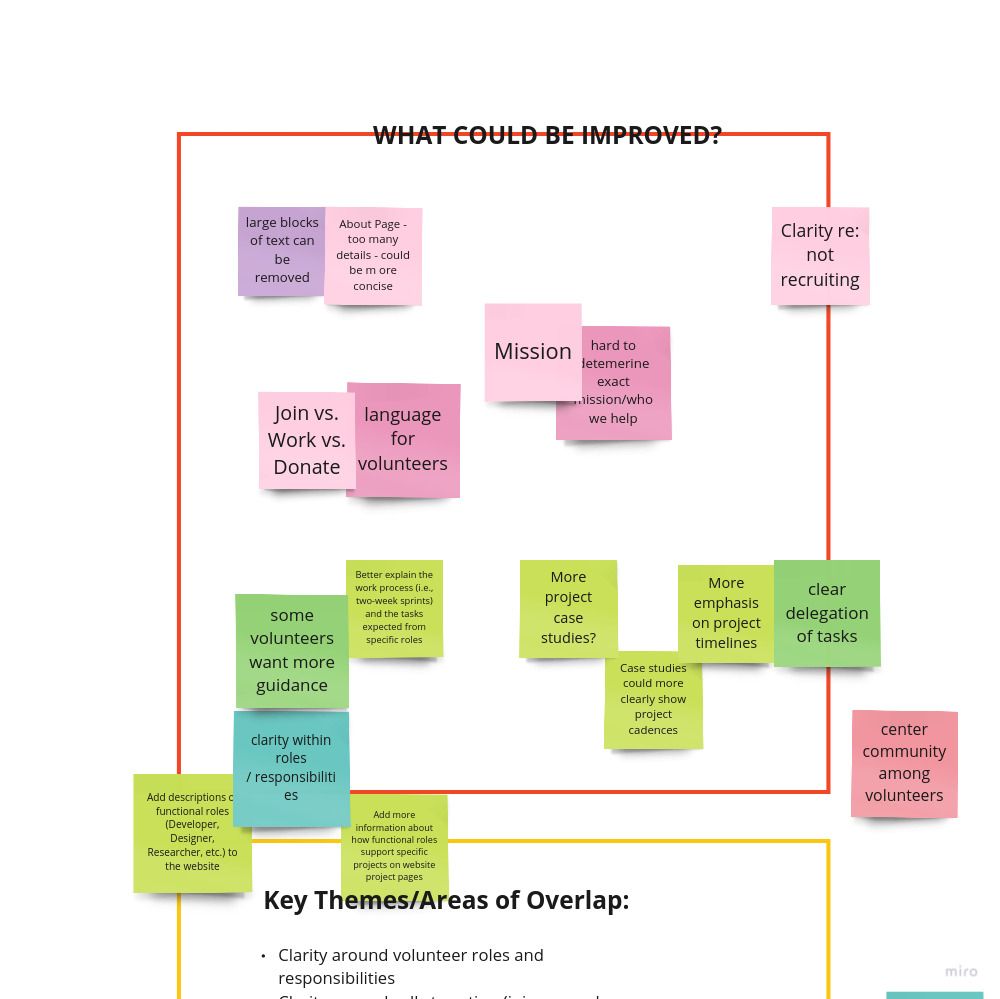Case StudiesBrigade Personas
Identifying Code for Chicago's target user groups and leveraging that insight to inform the website's content and organization operations.

Overview
Code for Chicago
Code for Chicago is a subsidiary of Code for America with the goal of making tech accessible to everyone. Through Civic Tech, our work can bridge the gap between nonprofits and technology. Code for Chicago operates as a pro-bono digital consultancy. Code for Chicago identities the needs of the community and partners with local organizations for Civic Tech projects. These roles include, but are not limited to: Developers, UX/UI Designer and UX Researchers.
The Challenge
When Code for Chicago launched its website back in 2019, there were a lot of assumptions that went into creating its content. There was no formal research facilitated to gather insight into who the users are and how might their needs be considered for the website’s user journey.
Approach
A series of remote user interviews were conducted between October 2022 to January 2023. The purpose of this study was to establish deep understanding of key user groups and identify user motivations for volunteering for CfC and other brigades. The researchers gathered and analyzed data from interviews with 9 active Code for Chicago volunteers. Data was synthesized and was leveraged to improve Code for Chicago’s website and serve as a baseline for further volunteer research.
Project Timeline
October 2022 to January 2023
Problem Statement
When users come to the Code for Chicago website, what is it that they are looking for? How might the Code for Chicago team design the website in a way that addresses our user's prioritized needs?
Our Approach
Test Development and Pilot Testing
A test-plan was created by the Meta Projects UX Research team. The test plan consisted of a problem statement, study purpose, scope, research questions, participant criteria, feature prioritization, logistics, test outline and script.
Recruitment
Participants were recruited through LinkedIn and sourced by team members. Participants completed a recruitment screening questionnaire which identified whether or not they were current volunteers for Code for Chicago (defined as: unpaid volunteers for CfC who have completed onboarding and have actively worked on a project within the last 6 months).
Who were the participants?
The required criteria was as follows:
- 18 years or older
- Internet access
- Must have participated at Code for Chicago previously within the last 6 months
Methodology
Meeting Format
The user interviews were conducted remotely via Zoom with a moderator and at least one notetaker. The meetings followed a conversation guide. Each session lasted between 40 to 60 minutes. The outline of the conversation guide were broken up into 3 sections: (1) learning about the participant, (2) their motivations for volunteering, and (3) their onboarding experience.
Facilitation & Synthesis
At least one member of the research team took notes on each session. Findings were compiled into an affinity diagram which identified key insights, pain points and opportunities. After identifying these key parts, the research team submitted final insights and recommendations. Each interview was recorded so the entire research team could review it.
Outcome
In summation the key themes identified were broken up into four categories: (1) Volunteers and their Motivations, (2) Onboarding to Code for Chicago, (3) Approaches to Volunteer Work, and (4) Supporting Volunteer Needs and Goals.
Recommendations
The follow were a summary of the overall recommendations. Further insight and analysis can be gathered from the research report.
- Create case studies to introduce new volunteers to a range of possible project cadences and approaches.
- Maintain an open structure that allows people to demonstrate initiative and take on leadership roles, but provide additional support for volunteers who desire more direction and for volunteers who take on most of the work for their role, such as guides, templates, standardized documentation practices, and other materials.
- Set clear expectations for project timelines and pace of work (for example, on the website and in onboarding documents)
- Support volunteers in learning how to strengthen their job materials without completing an entire project (for example, by incorporating parts of their project work into a case for their portfolio).
- Center community among volunteers and leverage the opportunities around mentorship, networking, and socializing for volunteers to interact and help each other achieve their goals.